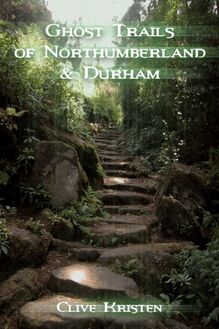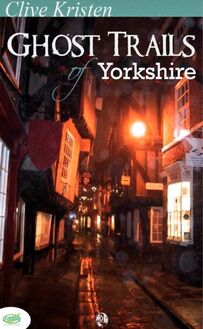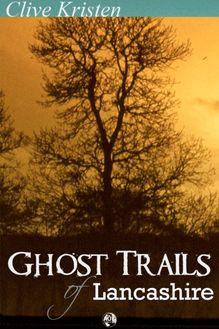Ghost Trails of Northumberland and Durham , livre ebook
95
pages
English
Ebooks
2014
Vous pourrez modifier la taille du texte de cet ouvrage
Obtenez un accès à la bibliothèque pour le consulter en ligne En savoir plus
Découvre YouScribe et accède à tout notre catalogue !
Découvre YouScribe et accède à tout notre catalogue !
95
pages
English
Ebooks
2014
Vous pourrez modifier la taille du texte de cet ouvrage
Obtenez un accès à la bibliothèque pour le consulter en ligne En savoir plus
Publié par
Date de parution
10 juin 2014
Nombre de lectures
0
EAN13
9781849893831
Langue
English
Title Page
GHOST TRAILS OF NORTHUMBERLAND & DURHAM
By
Clive Kristen
Publisher Information
Ghost Trails Of Northumberland & Durham Published in 2011 by
Andrews UK Limited
www.andrewsuk.com
This book is sold subject to the condition that it shall not, by way of trade or otherwise, be lent, resold, hired out or otherwise circulated without the publisher’s prior written consent in any form of binding or cover other than that in which it is published, and without a similar condition being imposed on the subsequent purchaser.
Copyright © 2011 Clive Kristen
The right of Clive Kristen to be identified as author of this book has been asserted in accordance with section 77 and 78 of the Copyrights Designs and Patents Act 1988.
Author’s Note
Dear Ghosthunter,
This book is a compilation of three earlier titles with new material added. As before, the format is ‘tour and explore’ trails linked by supernatural themes.
These trails have been constructed to take best advantage of the great natural beauty of the region, and to bring to life Northumbria’s rich historical and cultural heritage. For the first time two city trails are presented - for Durham and Newcastle. A recommended ‘tour’ is offered for the city trails. For the rest the sites are listed alphabetically and the ghosthunter is invited to invent his own route.
Touring times for each trail vary from a few hours to whole days. For those who prefer relaxed ghosthunting each can be conveniently broken down into sections. The guides provided with each section are intended only to help make sense of the text.
Whist every effort has been made to produce accurate historical and topographical detail, the reader will understand that no area of human consciousness is more prone to misinterpretation, confusion, and even dishonesty than the supernatural.
In an attempt to make sense of this dilemma an attempt has been made to balance traditional accounts of supernatural phenomena, archive and historical material with the common sense of local knowledge. When it has been necessary to select one version of a story from several, contemporary and local accounts have taken precedence. The historical notes are intended to fill out detail where it has not been appropriate to do so within the main body the text.
I am indebted to archivists and librarians in Britain and abroad without whose patience and perseverance this would have been a very much slimmer volume, and to listeners to Radio Newcastle for a constant supply of new source material.
I also extend grateful thanks to my wife, Maureen, for her encouragement, ghosthunting and editing skills.
Clive Kristen
Taking Care in the Countryside
Most of the sites in this book can be accessed from public rights of way. Where this does not happen visitors can get a good impression of a site from suggested viewpoints.
Much of the land is farmed, and should be treated with respect. In a few cases, access is restricted and the necessary consents should be obtained. Special care is required during the lambing season and visitors are requested to follow the guidelines of the country code. Please follow footpaths, close gates, and keep dogs under close control. Litter is unsightly and can cause injury and suffering to animals.
Some of the buildings mentioned are private homes. Please do not trespass or behave intrusively. Property owners have been generous in the information they have provided. Please ensure that their right to quiet and privacy is preserved.
These tours are designed primarily for the motorist and none of the walks suggested are arduous. Nevertheless, Northumbrian weather can be unpredictable - even in summer. It is suggested that visitors do not set out on a walk alone. They should have adequate footwear and a waterproof garment. A good map and compass are also highly recommended.
Trail 1 - Coquetdale
Alwinton
The church of St. Michael and All Angels at Low Alwinton is worth a visit. Old tombstones form the footpath and other headstones feature the skull and crossbones.
The church itself is an unusual. It is built on a slope with the altar at the highest point, and the chancel above the nave.
The Reivers Return
Clennel Street was once the most famous of the ‘thieves rodes’. The hall, which incorporates a pele tower, is first mentioned in the border survey of 1541 as ‘ the property of Percival Clennel, gent, newly reparelled and brattyshed by the same Percival.’
Bratticing was an important part of the defence system. It was a kind of wooden staging built to stick out beyond the parapet. Loopholes were strategically placed so that the foot of the walls could been seen. Later, stronger, designs placed the loopholes especially to facilitate the dropping of stones or other missiles onto the heads of unwelcome visitors.
It is not known how old the pele tower is. The earliest well worn date stone is usually read as 1365.
A report of 1541 said it was impossible to encourage people to live in this area because of the regular Scots raids. The tower contains a reivers’ dungeon. Regular hangings took place on a conveniently sturdy old oak near the hall.
Rob’s Ride
A phantom associated with the hall is a heavily armed horseback rider known only as Rob.
Tradition has it that he rides to the hall and, without dismounting, bangs loudly on the door with the base of his sword. If the door is opened he vanishes immediately. If not, he sets about pummelling the woodwork with a heavy war axe.
As there are no obvious signs of such savage treatment to the present doors it is assumed that Rob is redundant.
Cragside
A visit to the Cragside House and Estate near Rothbury is highly recommended.
Cragside, now in the care of the National Trust, is the classic creation of a Victorian genius, Lord Armstrong. The house is a model of practicability and style harnessed in harmony. The planting of seven million shrubs and trees was the cornerstone of a massive landscaping scene.
Nelly’s Moss is a small lake that has somehow become associated with a witch’s ‘trial by water’. The ‘witch’, Nelly, allegedly met her end in those murky waters. The lake is for the most part artificial, and the story almost certainly the same. Equally difficult to accept are stories of spectral children who are said to glide above the waters of Tumbleton lake. There are no records of drownings or disappearances.
Great Tosson
The present condition of Great Tosson Tower - ‘a ragged shell of a pele with the highest fragments of walls about 30 feet high’ - is due to centuries of decay. This was once ‘part of Lord Ogle’s inheritance’. A survey carried out during the reign of Henry VIII reveals that the tower was already badly neglected.
Most of the facing stones have been taken for local building. What remains today is mainly the rubble core of walls. These were made from small rocks taken from the river and cemented together with hot lime.
The pele was part of the chain of castles and towers in the Coquet Valley. When Robert Bruce destroyed Hepple Tower (c. 1310) the De Hepple family moved their ‘court’ to Tosson. For a few years it became a place of some importance. Records tell us that each night two men kept watch from the high walls for signs of Scots hostility. A rider was also permanently employed - ready to be ‘despatched with haste’ - to warn others of an attack. Other contingency plans included the constant readiness to light the great beacon’ on Simonside.
The Miller’s Daughter
The tale of Katherine the miller’s daughter originates from the turn of the 15 th century.
Katherine, who was born at Tosson Mill, grew up to be a famous beauty. Although short of stature, she was ‘bold as a vixen’ and could charm any man with a smile.
Katherine was determined to make her looks work for her in the social climbing stakes. She began her ‘apprenticeship’ with the local garrison. Her reputation spread and she soon found favour with William Tailbois, the soldier son of a noted local family.
This was the inspiration she needed. From Tailbois it was not too great a step to the object of her ambitions - Harry Percy, known as Hotspur.
There have been whispers down the centuries that Hotspur earned his nickname for reasons other than impulsive acts of valour. Whether this was true or not, he clearly had what it takes to encourage fidelity. After Katie met Harry she never looked at another man.
But Harry soon tired of the miller’s daughter. These were troubled times, and whilst Hotspur had time for affairs, he also had to consider the affairs of state. Other women and other minor matters - such as planning the next campaign - were constant distractions for him.
Nevertheless, he recognised that Kate had qualities that would be wasted on common men. He therefore offered to pass Katherine on to his uncle, Thomas, Earl of Worcester.
Katherine didn’t think much of this arrangement, which was apparently rather like swapping D’Artagnan for Quasimodo.
“Better than he,” she told Hotspur, “would be to go to a nunnery.” Hotspur made the arrangements and Katherine entered the sisterhood at York.
One conclusion of the story has Katherine taking her own life after hearing of Hotspur’s death at Shrewsbury. Another version has her returning to Coquetdale, marrying, and spending the rest of her days as a respected member of the community.
A Spectral Song
Below the site of the mill is a flat expanse of land running down to the riverside.
From time to time an unusual spectre has been seen walking on the mill side of the river. It is the figure of a woman, dressed in the habit of


